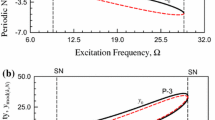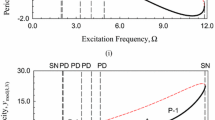Abstract
The Duffing oscillators are widely used to mathematically model a variety of engineering and physical systems. A computational analysis has been initiated to explore the effects of nonstationary excitations on the response of the softening Duffing oscillator in the region of the parameter space where the period doubling sequences occur. Significant differences between the stationary and nonstationary responses have been uncovered: (i) the stationary transitions from T to 2T, from 2T to 4T ... etc. branches at the stationary period doubling bifurcations are smooth, in nonstationary cases they exhibit jumps to the near stationary branches at the values of the control parameters greater than those for the stationary; this phenomenon is called penetration (delay or memory). The lengths of the penetrations is being compressed to zero with the increasing number of the iterations. (ii) The stationary and nonstationary responses eventually settle on different limit motions, the nonstationary has modulated components. (iii) The jumps appearing in the stationary bifurcation diagram at 2T from the upper to the lower branches of the (x, f) and (x, Ω), i.e., (displacement-forcing amplitude) and (displacement-forcing frequency), diagrams have been replaced by continuous transition in the nonstationary diagram climinating thus the discontinuity. Apart from these differences, some specific characteristic nonstationary responses have been observed not encountered in the stationary cases: (iv) the appearance of the ‘window’ in the nonstationary limit bifurcation diagrams. (v) The nonstationary limit motions located on the upper (lower) branches of the (x, f) or (x, Ω) diagrams expanded rapidly to the lower (upper) branches. (vi) The stationary and nonstationary bifurcation diagrams are extremely sensitive to the initial conditions, manifested by the mirror reflections, called the flipflop phenomenon. (vii) The nonstationary limit motion has been characterized by a complex phase portrait, the appearance of the Cantor-like set of the limit motion bifurcation plot, and continuous spectral density. For the purpose of comparison, a stationary period doubling sequence T, 2T,..., 2n T,... stationary limit motion, χST which is known to be chaotic has been determined. A far reaching observation has been made in the process of this study: the determination of the nonstationary bifurcations, their branches and limit motions, has been independent of the calculations of the stationary ones, indicating, thus, the existence of an independent class of nonstationary (time varying) dynamics.
Similar content being viewed by others
References
Mitropolski, Y. A., Problems of the Asymptotic Theory of Non-Stationary Vibrations, Davy, New York, NY, 1965.
Evan-Iwanowski, R. M., Resonance Oscillations in Mechanical Systems, Elsevier, Amsterdam, 1976.
Guckenheimer, J. and Holmes, P., Nonlinear Oscillations, Dynamical Systems, and Bifurcations of Vector Fields, Springer-Verlag, New York, NY, 1983.
Thompson, J. M. T. and Stewart, H. B., Nonlinear Dynamics and Chaos, Wiley, New York, NY, 1986.
Moon, F. C., Chaotic Vibrations: An Introduction for Applied Scientists and Engineers, Wiley, New York, NY, 1987.
Seydel, R., From Stability to Chaos, Springer-Verlag, New York, NY, 1988.
Rasband, S. N., Chaotic Dynamics of Nonlinear Systems, Wiley, New York, NY, 1990.
Tabor, M., Chaos and Integrability in Nonlinear Dynamics, Wiley, New York, NY, 1989.
Dowell, E. H. and Pezeshki, C., ‘On the understanding of chaos in Duffing's equation including a comparison with experiment’, Journal of Applied Mechanics 53, 1988, 5–9.
Anderson, G. L. and Tadjbakhsh, I. G., ‘Stabilization of Ziegler's pendulum by means of the method of vibration control’, Journal of Mathematical Analysis and Applications 143, 1989, 198–223.
Szemplinska-Stupnicka, W., ‘Bifurcations of harmonic solution leading to chaotic motion in the softening type Duffing's oscillator’, International Journal of Non-Linear Mechanics 23, 1988, 257–277.
Huberman, B. A. and Crutchfield, J. P., ‘Chaotic states of anharmonic systems in periodic fields’, Physical Review Letters 43, 1979, 1743–1747.
Tran, M. H. and Evan-Iwanowski, R. M., ‘Nonstationary response of self-excited driven system’, International Journal of Non-Linear Mechanics 25, 1990, 61–71.
Moslehy, F. A. and Evan-Iwanowski, R. M., ‘The effects of non-stationary processes on chaotic and regular responses of the Duffing oscillator’, International Journal of Non-Linear Mechanics 26, 1991, 61–71.
Evan-Iwanowski, R. M. and Abhyankar, N. S., ‘Nonstationary effects on the chaotic Duffing oscillator’, Proceedings CSME Mecanical Engineering Forum, Toronto Conference, 1990, 1–6.
Nayfeh, A. H. and Sanchez, N., ‘Bifurcations in the forced softening Duffing oscillator’, International Journal of Non-Linear Mechanics 24, 1989, 483–497.
Soliman, M. S. and Thompson, J. M. T., ‘Transient and steady state analysis of capsize phenomena’, Applied Ocean Research 13, 1991, 82–92.
Berge, P., Pomeau, Y., and Vidal, C., Order within Chaos, Wiley, New York, NY, 1984.
Erneux, T., Reiss, E. L., Holden, L. J, and Georgiou, M., ‘Slow passage through bifurcation and limit points’, Dynamic Bifurcations, Springer-Verlag, New York, NY, 1990, 14–28.
Joshi, L. J., ‘Analysis of velocity and temperature fluctuations in turbulent shear flows’, Ph.D. Dissertation, Department of Mechanical and Aerospace Engineering, University of Central Florida, 1989.
Johnson, A. D., Private Communication, Draft of the Doctoral Dissertation, Oxford University, 1987.
Byatt-Smith, J. G., ‘2π periodic oscillations of Duffing equation with negative stiffness’, SIAM Journal of Applied Mathematics 47, 1987, 60–91.
Nayfeh, A. and Asfar, K. R., ‘Non-stationary parametric oscillations’, Journal of Sound and Vibration 124, 1988, 529–537.
Evan-Iwanowski, R. M. and Ostiguy, G. L., ‘Recent developments and an agenda for nonstationary chaotic motions’, Third Conference on Nonlinear Vibrations, Stability and Dynamics of Structures and Mechanisms, June 25–27, 1990, Blacksburg, VA, 1–10.
Matkowsky, B. J. and Reiss, E. L., ‘Singular perturbations of bifurcations’, SIAM Journal of Applied Mathematics 33, 1977, 230–255.
Wiggins, S., Global Bifurcations and Chaos, Springer-Verlag, New York, NY, 1988.
Ueda, Y., ‘Steady motions exhibited by Duffing's equation: A picture book of regular and chaotic motions’, Report, Institute of Plasma Physics, Nagoya University, 1978, 1PPJ-434.
Grebogi, C., Ott, E., and Yorke, J. A., ‘Crises, sudden changes in chaotic attractors and transient chaos’, Physica 7D, 1983, 181–200.
Author information
Authors and Affiliations
Rights and permissions
About this article
Cite this article
Lu, C.H., Evan-Iwanowski, R.M. Period doubling bifurcation problems in the softening Duffing oscillator with nonstationary excitation. Nonlinear Dyn 5, 401–420 (1994). https://doi.org/10.1007/BF00052451
Received:
Accepted:
Issue Date:
DOI: https://doi.org/10.1007/BF00052451




